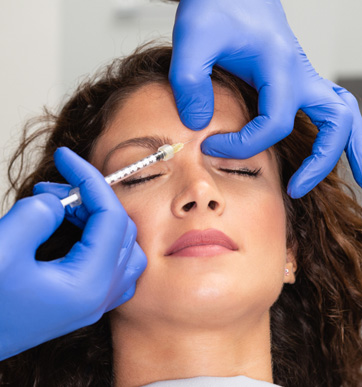 Cosmetic Dermatology
Cosmetic Dermatology
The Difference between Fillers and Neurotoxins Q&A Interview with Dr. Jennifer Herrmann
As you age, your skin loses its natural elasticity and produces fewer oils, becoming drier, weaker, and less flexible. Exposure to sunlight compounds this natural decline, as ultraviolet light breaks down the deep layers of your skin’s connective tissue. When this strong, flexible support system sustains too much damage, your skin begins to show signs of wrinkling and sagging. Enter dermal fillers and wrinkle relaxers such as Botox. Most patients seeking a dermal filler like Juvéderm or a wrinkle relaxer like Botox, simply know these names because the manufacturers have spent millions advertising them, but which product is best for you? What are the difference between fillers and wrinkle relaxers? In this Question & Answer interview board-certified dermatologist Dr. Jennifer Herrmann answers those important questions.
Q. What are dermal fillers?
Dermal fillers are substances that are injected into the skin to help restore volume or smooth lines or folds. There are three main families of fillers: those made from hyaluronic acid, a natural sugar-like substance (Restylane and Juvederm); those derived from calcium (Radiesse); and those made from lactic acid (Sculptra). Importantly, all of these products are biocompatible with the skin meaning that they are recognized by your body as natural and almost never cause allergic reactions. Hyaluronic acids are the most common type of filler. Hyaluronic acid is a sugar that binds up to 1000 times its weight in water, giving the skin a soft, plump and youthful appearance. Manufacturers increase the stability of hyaluronic acid when processing it into fillers and give them different degrees of stiffness, projection, and elasticity depending on where they might be used on the face. Softer fillers are more appropriate for lip plumping while firmer fillers are better on the cheek bones to give lift and projection. I think of both calcium-based and lactic acid-based fillers as products that volumize more than fill. These products help stimulate collagen synthesis, so areas of volume-loss can be augmented more slowly over time. Because these “stimulatory” fillers encourage native collagen growth, they tend to last longer than the hyaluronic acid-based fillers.
Q. What are wrinkle relaxers?
Wrinkle relaxers are products that help smooth lines made by facial animation. They work by disrupting the communication between muscles and nerves, which prevents muscles from continuously contracting to form lines, which become more etched into e skin over time. Muscle relaxers are used to help smooth forehead lines, “angry 11s,” and crow’s feet, but there can also be used to smooth the skin, slim the jaw, and help reduce excess sweating.
Q. What are the most common dermal fillers?
The hyaluronic acid fillers are the most common family. They are often mixed with numbing medication, so that they are comfortable when injected. Unlike other products, this family is reversable, making them very versatile. Because there are so many varieties, they can be used for smoothing and sculpting both on and off the face.
Q. What are the most common wrinkle relaxers?
Botox, Dysport, Xeomin, and Jeaveau are the 4 main wrinkle relaxers. These products all rely on the same “active ingredient,” but are delivered into their place of action slightly differently.
Q. Are all these products comparable or is one better than the other?
Most of the muscle relaxers are quite similar because they all rely on the same active agent, but the fillers vary substantially. I never expect my patients to know which filler they need—that’s my job. It’s important to see a board-certified dermatologist that has excellent understanding of the different properties of each filler type and of a patient’s anatomy. Using the right filler judiciously in areas where it’s best suited not only yields more natural results, but it also allows us to use less product to get better results. This translates to more cost-effective treatments for patients. Having an thorough understanding of anatomy is also critical for achieving natural results, as well as maintaining patient safety. Fillers injected into unsafe zones can lead to catastrophic consequences.
Q. How long do the results of dermal fillers and wrinkle relaxers last?
Most muscle relaxers last 3-4 months, but patients often need treatments less often over time, if they have trained their muscles not to habitually “wrinkle” their skin. Fillers may last anywhere from 6 months to 2 years, depending on the type used and amount injected.

